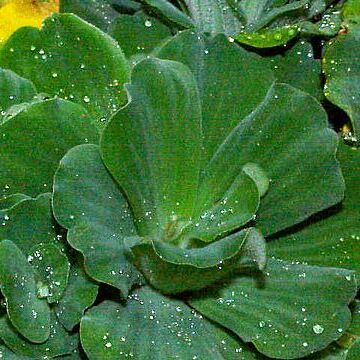Plants aquatic, floating on quiet water, acaulescent or nearly so, the caudex very short, often emitting stolons with new rosettes of leaves at their end, these later becoming detached from the parent plant; leaves numerous, crowded, spirally arranged and forming a rosette, thick and spongy, covered on both surfaces with short, crowded, few-celled hairs; stipular sheath free almost to the base, thin and scarious; inflorescences very small and inconspicuous, subsessile; spathes foliaceous, whitish, glabrous within, pilose outside, somewhat constricted at the middle on either side, the margins connate to the middle, the blade ovate, acute, subcucullate; spadix shorter than the spathe, adnate for two-thirds its length to the spathe, the pistillate portion 1-flowered, the staminate 2-to 8-flowered, the flowers verticillate; flowers unisexual, naked; staminate flower with 2 stamens, these short-connate, forming a sessile, oblong-ovoid synandrium slightly depressed at its apex, the anther cells opening each by 2 vertical slits; ovary monogynous, ovoid, obliquely attached to the spadix, 1-celled; ovules numerous, orthotropous, sessile, 4-to 6-seriate; style short, terminal, the stigma obtuse, subhemispheric-penicillate; fruit baccate, ovoid, many-or few-seeded, irregularly rupturing; seeds cylindroid, slightly attenuate at the base, subtruncate at the apex, excavate at the middle; endosperm copious.
Small, free-floating, acaulescent, rosulate, perennial, freshwater, aquatic herbs with pendent fibrous roots. Leaves densely pubescent, subsessile; blade very variable in size and shape; primary veins parallel. Inflorescence small, hidden among leaf-bases. Spathe constricted centrally, basal part slightly inflated, convolute, apical part ± erect, expanded, acute-acuminate. Spadix highly reduced, adnate to spathe. Flowers unisexual, lacking perigon. Staminate flowers 2–8, connate into a single whorl borne on a short stipe subtended by shallow basal cup, each flower a synandrium of 2 connate stamens. Pistillate flower solitary, basal, consisting of a single, oblique, unilocular ovary; ovules numerous on single basal placenta, style slender, curved; stigma subspherical. Fruit a thin-walled several-seeded berry, dehiscing by irregular splits. Seeds subcylindric, rugose, with abundant endosperm.
Herbs, aquatic, floating on still or slow-moving water. Stolons frequently produced, terminating in young plants. Leaves appearing before flowers, several, floating to ascending or nearly erect, in dense rosette, sessile to subsessile; blade light green to grayish green, simple, not peltate, obovate to spatulate, base obtuse or rounded, apex subtruncate, rounded, or notched, pubescent; primary veins nearly parallel. Inflorescences: peduncle erect, very short, pubescent; spathe greenish, closed basally, open apically, exposing tip of female flower and male spadix; spadix basally adnate to spathe. Flowers unisexual; staminate and pistillate on same plant; staminate flowers distal to single pistillate flower; perianth absent. Fruits not embedded in spadix, green, turning brown at maturity. Seeds (1--)4--10(--20), mucilage probably present. x = 14.
Floating mat-forming stoloniferous aquatic; stem condensed; leaves shortly petiolate, suboblong, hairy, inflated, in a lettuce-like rosette to c. 30 cm diam. (usually less). Inflorescence mostly solitary, physiognomically axillary, inconspicuous at leaf bases, c. 1 cm long; spathe hairy outside, slightly constricted; limb subcampanulate, white inside; spadix shorter than spathe; female zone a solitary naked pistil adnate to spathe; male zone a stipitate ring of anthers subtended by a membranous collar; appendix absent. Fruit a multi-seeded inconspicuous greenish berry.

